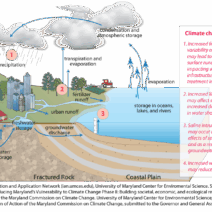Climate change: a phenomenon that conjures images of melting ice caps, rising sea levels, and unprecedented weather patterns. But how long has it been a problem? This inquiry leads to an exploration that surpasses simple timelines. It’s not merely a question of years; it’s a saga of humanity’s journey alongside an ever-changing Earth. So, grab a moment, and let’s delineate the intricate tapestry of climate change history.
To understand the context of climate change, one might whimsically ask, “How did we get here?” The answer traces back to the very dawn of civilization. While early humans were predominantly nomadic hunter-gatherers, they developed agricultural practices around 10,000 years ago, significantly impacting local ecosystems. This transition marked humanity’s first substantial interface with climate. Agriculture demanded a stable climate, and with that stability arose dependence. As civilizations burgeoned, so too did their carbon footprints.
With the advent of the Industrial Revolution in the 18th century, the relationship between humanity and climate transformed drastically. The widespread adoption of coal, the development of steam engines, and a growing dependency on fossil fuels heralded an era of unparalleled emissions. As factories belched smoke into the atmosphere, the consequences began to manifest. The dawning awareness of these implications coincided with early scientific discoveries; in the 19th century, scientists like John Tyndall and Svante Arrhenius began elucidating the greenhouse effect. However, the implications of their findings lingered mostly within scholarly circles.
Fast forward to the mid-20th century, when the impact of climate change became more tangible and troubling. The Great Smog of London in 1952, a devastating pollution event that claimed thousands of lives, served as a grim harbinger of the perils of unchecked industrial activity. At this juncture, climate change began emerging from the shadows of academia into public discourse. Scientists employed prognostic models that indicated a warming planet, igniting debates that echoed through political and social spheres.
A pivotal moment arrived in the 1970s. As environmental awareness burgeoned, a dual recognition emerged: one that acknowledged both human culpability in greenhouse gas emissions and the urgent necessity to address them. The formation of organizations like the Environmental Protection Agency (EPA) in the U.S. marked a concerted effort to regulate pollutants. It was during this epoch that the first Earth Day was celebrated in 1970, galvanizing global activism and fostering a collective consciousness surrounding environmental stewardship. Yet, while many celebrated progress, others questioned whether such initiatives could adequately challenge the overwhelming inertia of industrialization.
By the 1980s, scientific consensus emerged around the reality of anthropogenic climate change. The Intergovernmental Panel on Climate Change (IPCC) was established in 1988, further solidifying the international commitment to tackle this pressing issue. Policymakers were urged to implement strategies for mitigation, yet the tapestry of economic interests and political agendas made this a Herculean task. Fossil-fuel-dependent economies resisted the notion of transitioning toward sustainable energy sources, giving rise to protracted debates over environmental policies.
The 21st century ushered in a new chapter that juxtaposed the perils of climate change with the potential for innovation. Reports such as the IPCC’s fourth assessment in 2007 painted a dire picture, wherein unchecked fossil fuel consumption could lead to catastrophic global warming. The juxtaposition of science and public perception sparked a fascinating dichotomy: while a fraction of society recognized the urgency for action, a significant portion remained entrenched in skepticism.
In recent years, the onslaught of extreme weather events—hurricanes, droughts, wildfires—has served to catalyze public discourse yet again. Climate activists implore individuals and governments alike to recognize the indispensable need for a paradigm shift toward sustainability. The Paris Agreement, adopted in 2015, epitomizes this movement, representing a collective pledge from nations to limit global warming to well below 2 degrees Celsius compared to pre-industrial levels. This ambitious objective, however, raises an intriguing question: can we, as a global community, meet our commitments in the face of entrenched opposition and economic interests that favor the status quo?
Beyond treaties and agreements lies the opportunity for individual and grassroots movements to effect tangible change. While global summits capture headlines, local initiatives may well prove to be the undercurrents driving progress. Renewable energy is no longer just an ideal; it is becoming an everyday reality. Communities worldwide are adopting solar panels and wind turbines, symbolizing a burgeoning rebellion against fossil fuel dependence.
As humanity grapples with the enormity of its impact on climate, it becomes apparent that the historical trajectory of climate change is entwined with tales of resilience, denial, action, and activism. As we reflect on this complex history, one must consider: what legacy do we wish to leave for future generations? The challenges ahead are monumental, yet they present an invitation for innovation, cooperation, and tenacity. The journey from awareness to action is fraught with difficulties, yet now is a critical juncture. Each decision, however small, contributes to the grand equation.
As we stand at this critical crossroads in the history of climate change, the question looms larger than ever: are we ready to confront the challenge? The past offers lessons; the present is rife with opportunity. The future remains unwritten, and it beckons for our most profound engagement.

